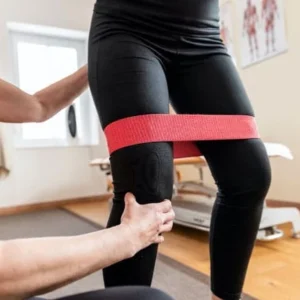Kegel Exercises for Vaginal Tightening
Introduction: Sarah’s Story
Have you ever felt that a small, seemingly insignificant change in your body could completely affect your life—especially your relationship with your partner?
For many women, childbirth is a transformative experience that brings joy, but it can also lead to unexpected challenges. After giving birth to her second child, Sarah found herself dealing with something she hadn’t anticipated: a weakening of her pelvic floor muscles.
This, in turn, led to vaginal looseness, which made intimacy with her husband feel different—and not in a good way. Sarah’s relationship was beginning to suffer, and the stress of it all left her wondering if things would ever go back to the way they used to be.
Could something so simple as her pelvic health really affect the foundation of her marriage? The truth is, vaginal laxity after childbirth is more common than many women talk about, but it’s often a deeply personal concern. Women feel it, but sometimes they don’t know how to address it or where to turn for help. In Sarah’s case, after hearing a close friend mention Kegel exercises for postpartum recovery, she decided to give them a try.
The result? Her intimacy improved, her confidence soared, and her marriage was saved. Sarah’s story is just one example, but it resonates with many women who feel their pelvic health is silently impacting their relationships. If you’re feeling a similar strain, “Kegel exercises for postpartum recovery” might just be the solution you’ve been searching for.
Kegel Exercises Matter
Let’s dive into this topic that’s often overlooked in conversations about health but is truly fundamental to your well-being: pelvic floor health. Many of us go through life unaware of the importance of maintaining the strength of our pelvic muscles. The good news? You don’t need a gym membership or expensive equipment to take care of them. The secret lies in Kegel exercises for vaginal tightening. These exercises are simple, effective, and can be done at any time—whether you’re sitting at your desk, lying in bed, or even while cooking dinner.
You might be wondering, “Why does vaginal tightening matter?” Well, it’s more than just a cosmetic concern. Your pelvic floor muscles play a crucial role in controlling your bladder, enhancing sexual health, and supporting your body’s vital organs. Weak pelvic floor muscles can lead to urinary incontinence, vaginal looseness, and even decreased sexual satisfaction. But fear not—Kegel exercises for vaginal tightening are here to help!
By strengthening and toning these muscles, you can restore and maintain pelvic health, improve bladder control, and enhance your sexual well-being. So, if you’ve heard of Kegel exercises but aren’t quite sure where to start, this guide is for you.
What Are Kegel Exercises for Vaginal Tightening?
Kegel exercises for vaginal tightening are named after Dr. Arnold Kegel, a gynecologist who introduced them in the 1940s. His work focused on improving pelvic floor health, particularly for women dealing with incontinence or postpartum recovery. The exercises aim to strengthen the muscles that support the bladder, uterus, and vagina, creating a stronger, more toned pelvic floor.
The pelvic floor muscles are located at the bottom of your pelvis. They act as a hammock, supporting vital organs such as the bladder and uterus, and they are directly involved in sexual function. When these muscles weaken, it can lead to issues like bladder control problems, vaginal laxity, and sexual dysfunction. Kegel exercises for vaginal tightening target these muscles, helping you regain control and strength.
The Anatomy of the Pelvic Floor
The pelvic floor is a group of muscles that stretches across the bottom of your pelvis, forming a supportive sling. These muscles hold up organs such as the bladder, uterus, and rectum. When functioning properly, the pelvic floor provides the necessary support for these organs and helps with important bodily functions, such as urination, defecation, and sexual pleasure.
When pelvic floor muscles become weak, the organs they support can drop, leading to a condition known as pelvic organ prolapse. This can cause discomfort, difficulty in holding urine, and even problems during intercourse. Kegel exercises for vaginal tightening help strengthen these muscles, preventing prolapse and helping the body function more effectively.
The Benefits of Kegel Exercises for Vaginal Tightening
Let’s explore the powerful benefits of incorporating Kegel exercises for vaginal tightening into your daily routine. These exercises go beyond improving vaginal tightness—they offer a wide range of health advantages.
1. Stronger Pelvic Floor Muscles and Vaginal Tightness
The most common reason women turn to Kegel exercises for vaginal tightening is to restore vaginal tightness, especially after childbirth. During pregnancy and childbirth, the pelvic floor muscles stretch and weaken, leading to vaginal laxity. Over time, this can affect self-esteem and even sexual satisfaction.
The good news is that Kegel exercises for vaginal tightening can reverse this! By strengthening the muscles that support the vagina, you’ll notice an increase in tone and tightness, bringing back confidence and satisfaction. These exercises help regenerate the muscles that were once stretched, making them firm, toned, and responsive.
2. Improved Bladder Control
We’ve all heard of urinary incontinence—whether it’s sneezing, laughing, or exercising, a little leakage can happen. It’s more common than you might think, and it’s often linked to weak pelvic floor muscles. Fortunately, Kegel exercises for vaginal tightening can help.
By targeting the muscles that control your bladder, Kegel exercises for vaginal tightening can reduce or eliminate incontinence, giving you more control over your bladder. You’ll no longer have to worry about leaks during physical activities or embarrassing moments. With consistent practice, you’ll see a noticeable improvement in your ability to control your bladder, especially in situations that previously triggered leaks, like coughing, laughing, or sneezing.
3. Enhanced Sexual Health and Pleasure
Did you know that the pelvic floor muscles are closely connected to sexual pleasure? Strong pelvic muscles contribute to improved blood flow, greater sensitivity, and more intense orgasms. Kegel exercises for vaginal tightening not only restore vaginal tone but also enhance sexual satisfaction for both you and your partner.
As you perform these exercises, the muscles responsible for contractions during orgasm are strengthened, leading to heightened pleasure. When the pelvic floor muscles are tight and responsive, you may experience greater sensitivity and more intense sensations during sex. So, if you’re looking to improve your sexual health, Kegel exercises for vaginal tightening are an effective and natural solution.
4. Postpartum Recovery and Vaginal Rejuvenation
Childbirth takes a toll on your pelvic floor muscles. After giving birth, many women experience a weakened pelvic floor, which can contribute to vaginal laxity and a slower recovery process. Kegel exercises for vaginal tightening can help speed up postpartum recovery.
When done consistently, Kegel exercises for vaginal tightening strengthen the muscles that were stretched during delivery, promoting healing and restoring vaginal tone. They can be an essential part of your recovery process, helping you regain strength and confidence. Not only does this help with vaginal tightness, but it also aids in regaining bladder control that may have been affected during labor.
5. Improved Bowel Control
In addition to bladder control, the pelvic floor muscles play a crucial role in bowel control. Weakness in these muscles can lead to issues like constipation or difficulty controlling bowel movements. Kegel exercises for vaginal tightening can help by strengthening the muscles involved in bowel control.
If you’re struggling with issues such as constipation or lack of bowel control, strengthening your pelvic floor with Kegel exercises for vaginal tightening can make a significant difference. The stronger these muscles are, the easier it is to regulate bowel movements and prevent accidental leakage.
6. Reduced Risk of Pelvic Organ Prolapse
Pelvic organ prolapse occurs when the pelvic organs (bladder, uterus, or rectum) drop lower than usual due to weak pelvic floor muscles. This can lead to discomfort and, in some cases, requires surgical intervention. Performing Kegel exercises for vaginal tightening regularly can help prevent this condition by maintaining the strength and support of your pelvic floor muscles.
Pelvic organ prolapse can affect a woman’s quality of life, making daily activities like walking, sitting, and even sexual intercourse uncomfortable. By incorporating Kegel exercises for vaginal tightening into your routine, you’re taking proactive steps to avoid this condition and maintain overall pelvic health.
7. Boosted Confidence and Self-Esteem
When your pelvic floor is strong and healthy, you feel more in control of your body. Whether it’s tighter vaginal muscles, better bladder control, or enhanced sexual pleasure, Kegel exercises for vaginal tightening can give you a renewed sense of confidence. It’s not just about physical health—it’s about feeling empowered and comfortable in your own skin.
The benefits of Kegel exercises extend beyond physical health; they can greatly improve your mental and emotional well-being. As you experience the positive changes in your pelvic health, you’ll feel more confident in your body and empowered to take control of your health.
How to Identify Your Pelvic Floor Muscles
Before starting with Kegel exercises for vaginal tightening, it’s important to know where your pelvic floor muscles are. These are the muscles you’ll be engaging during the exercises. Here are a few simple steps to identify them:
- Stop Your Urine Midstream: The next time you’re in the bathroom, try stopping your urine flow. The muscles you use to do this are your pelvic floor muscles. Practice this a few times to get familiar with the feeling.
- Use Your Finger (Optional): You can gently insert a finger into your vagina and try to tighten the muscles around it. If you feel your muscles contract, you’ve found the right ones.
- Practice Contracting: Once you’ve identified the muscles, practice contracting and relaxing them. This will help you get comfortable with the sensation and ensure you’re doing the exercises correctly.
The Proper Technique for Performing Kegel Exercises for Vaginal Tightening
Now that you’ve located your pelvic floor muscles, it’s time to learn the proper technique for Kegel exercises for vaginal tightening. Here’s a step-by-step guide:
Step 1: Find a Comfortable Position
Start by lying down with your knees bent and feet flat on the floor. This position allows your pelvic muscles to relax and makes it easier to focus on the contraction. Once you’re comfortable, you can try doing the exercises in other positions, such as sitting or standing, as you get more advanced.
Step 2: Contract the Pelvic Floor Muscles
Gently squeeze your pelvic floor muscles as if you’re trying to stop urination or hold in gas. Hold the contraction for about 3-5 seconds, then relax for 3-5 seconds. Focus solely on your pelvic muscles—don’t engage your abdominal, thigh, or buttock muscles.
Step 3: Increase Intensity Over Time
As you get more comfortable, increase the duration of each contraction
. Aim to hold for 10 seconds as you advance. Start with 5-10 repetitions and work your way up to 20 or more. Aim to perform 3 sets of 10-15 reps daily.
Step 4: Stay Consistent
Like any exercise, consistency is key. Try to incorporate Kegel exercises for vaginal tightening into your daily routine. Set a reminder to do them each day, and soon you’ll begin to notice stronger pelvic muscles.
Common Mistakes to Avoid
Though Kegel exercises for vaginal tightening are simple, they can be easy to get wrong. Here are a few common mistakes to avoid:
- Overdoing It: Start slow and build up your repetitions. Doing too many at once can cause muscle fatigue.
- Holding Your Breath: Remember to breathe while doing the exercises. Holding your breath adds unnecessary tension and can make the exercises less effective.
- Not Fully Relaxing: Relax your pelvic floor completely between contractions. Not doing so can hinder progress.
How Often Should You Perform Kegel Exercises for Vaginal Tightening?
For the best results, perform Kegel exercises for vaginal tightening 3 sets of 10-15 repetitions daily. You should begin to see improvements within 4-6 weeks. Consistency is key, so try to make them part of your daily routine.
The Role of Kegel Exercises in Postpartum Recovery
After giving birth, your pelvic floor muscles need time to recover. Kegel exercises for vaginal tightening can help restore strength, tone, and control in your pelvic area. Wait until your doctor clears you for exercise before beginning.
Other Ways to Support Vaginal Health
While Kegel exercises for vaginal tightening are essential, they are just one part of the puzzle. Maintaining overall pelvic health involves a combination of strategies:
- Stay Hydrated: Drink enough water to keep your muscles and tissues hydrated.
- Eat a Healthy Diet: A diet rich in fiber supports healthy digestion, which is important for pelvic health.
- Exercise Regularly: A healthy body equals a healthy pelvic floor. Aim for regular exercise to maintain muscle tone.
- Manage Stress: Practice stress-reducing techniques like yoga and meditation to help reduce pelvic floor tension.
When to See a Doctor
If you experience pain, difficulty performing the exercises, or any unusual symptoms, it’s important to consult a healthcare provider. A pelvic floor therapist can provide personalized advice and help ensure you’re doing the exercises correctly.
Check out this article on Kegel exercises for postpartum recovery.
Conclusion
Kegel exercises for vaginal tightening are a powerful, natural way to improve your pelvic health. By strengthening your pelvic floor muscles, you can enjoy benefits like vaginal tightening, improved bladder control, better sexual health, and a faster postpartum recovery. With consistent practice, you’ll begin to feel the difference in a matter of weeks.
Both Kegels and certain yoga poses can help strengthen and stabilize the pelvic floor muscles. Therefore, I urge you to check out this article on the benefits of incorporating yoga into your fitness routine.
Start today, and take control of your pelvic health—your body will thank you!
FAQs
- How long will it take to see results from Kegel exercises for vaginal tightening?
- It typically takes 4-6 weeks of consistent practice to start noticing noticeable results.
- Can I perform Kegel exercises during pregnancy?
- Yes, Kegel exercises for vaginal tightening are safe and beneficial during pregnancy. They can help maintain pelvic floor strength.
- Are there any risks with Kegel exercises?
- When done correctly, Kegel exercises are very safe. Overdoing them or performing them incorrectly could lead to muscle fatigue.
- How can I make sure I’m doing Kegel exercises correctly?
- Focus on contracting the right muscles (the pelvic floor) and avoid engaging your abdominal, thigh, or buttock muscles.
- How often should I do Kegel exercises for vaginal tightening?
- Aim for 3 sets of 10-15 repetitions per day for the best results.







This Post Has One Comment